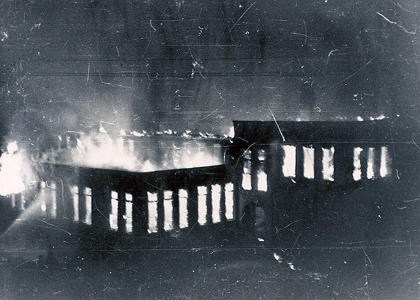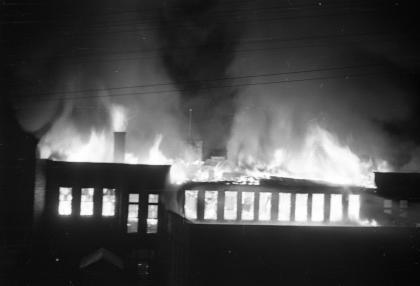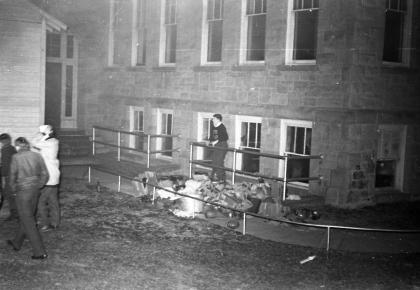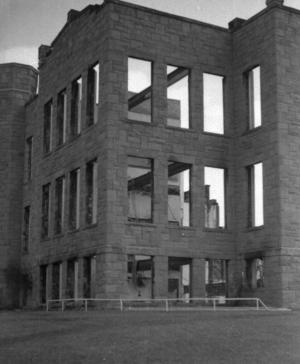FIRE LEVELS CALHOUN HIGH SCHOOL 1942 - Destruction Happens During Troubling Times

Calhoun County High School Burns
(Photo courtesy of Virginia Weaver Buck)

The town was awakened by the roaring fire and David
Hathaway took his camera (David Hathaway Photo)
The burning of Calhoun County High School in 1942 came amid troubling times, the end of the Great Depression, the chaos of World War II, students leaving to fight in the war, and the conflict over the firing of principal Don McGlothin, who refused to make a Jevohahs Witness student say the pledge and salute the American flag.
There was much speculation that the destruction was related to arson.
The following is a written account of the burning of Calhoun County High School, by then student David Hathaway (now deceased), during his junior year:
A great misfortune occurred on Friday night, February 20, 1942:
I was seated in my bedroom on Main Street in Grantsville, selecting the play that the Junior Class was to present at the close of school. A glance at the clock showed the time to be 12:30 a.m. Out of the still night there came a low cry. It passed my ears unheeded.
Again the cry came. This time I heard a distinct, "Hey Dave!"
I sprang to the window to answer the call. There in the moonlight stood Forrest Gunn. In answer to my question he told me what the excitement was. He said, "The High School is on fire!" In a moment he was in my room and I was gathering my photographic equipment and leaving for the scene of the fire.
Arriving on the scene, the fire had been discovered but a few minutes earlier and the fire hose had not yet arrived. (By way of explanation, Forrest Gunn lives next door to the officer of the law, Dudley Lutz, and he is the first to get the word. The people always tell Dudley about the fires first and "Gunny" heard from them. After dressing, he came and got me.
On arriving the fire was confined to one room but before the hose could be put into operation, it had spread to the second floor. Grantsville has no fire department and no trained firemen.
To top this off, the temperature was about 15 degrees above zero and the hose had frozen. It had been used earlier for washing the streets and had been put away wet. It took about twenty to twenty five minutes to thaw out the hose to do any fire fighting whatsoever.
When the school was built, it was designed for hot air heating, plastered conduits through the walls and floors and it was here that the fire spread.
Freezing weather made it difficult to do anything to save the structure. Water froze immediately upon the walk and it was even a job to stand up on the lawn.
The interior of the building was so filled with smoke that it was impossible to see any distance inside.
Ronzel Francis, the band director, Andy Stemple, owner of the dry cleaning establishment, and Robert Elliott were on the roof, shooting water through the ventilators when someone knocked a hole in the wall below, thus creating a draft and the flames leaped out of the vents, nearly burning the ones with the fire hose on the roof.
The fire spread over the roof like it was soaked in gasoline. This nearly trapped the firefighters on the roof. The smoke was so thick that they had to follow the fire hose back to safety.
Argle Hannah, Smokey Stump, Ronzel Francis and I crossed the burning main hallway to the band room and began taking the band instruments out to safety.

Students examining the destruction (David Hathaway Photo)
It was estimated that we saved over a thousand dollars worth of horns and music each.
Later, Argle and I went into the basement and took out chairs and tables. That was exciting! The ceiling overhead was burning and falling through.
Soon hope was abandoned for the saving of the school building, so all that I could do was take pictures.

(David Hathaway Photo)
By 6:00 a.m. there was nothing left but the stone walls and an inferno within them. There were forty some typewriters burned, estimated to be worth $100 each.
School classes started again the following week. Where are we having it? Everywhere My schedule runs as follows:
First period - History in the Masonic Hall game room.
Second period - Geography in the upstairs of the Chevrolet Garage.
Third period - English in the Methodist Church sanctuary.
Fourth period - Typing in the basement of Matthew's Store
Fifth period - French in the garage again.
Sixth period - Band in the show room of the Chevrolet Garage.
Study hall was held in the American Legion Hall and classes changed on the sounding of a large dinner bell, hung outside by Dudley Lutz's Shoe Shop.
Saturday the cornerstone for the Court House was laid (1942) and the school T band played for the event and just about froze.
To make matters worse, just before the school burned we lost our principal, Don McGlothlin.
There happened to be a member of the Jehovah's Witnesses sect attending school and during assemblies she refused to salute the flag or stand during the National Anthem.
This caused a lot of comment because of patriotism during World War II, and the State Board of Education took the matter under consideration in a special meeting.
As it was, Mr. McGlothlin had been excusing her from the assemblies and the board's decision was to have her thrown out of the school.
This seemed to be contrary to Don's beliefs, So, to put it very simply, they put both the girl and Mr. McGlothlin out at the same time.
See related stories:
LANDMARK GRAVEN IMAGE CASE IN CALHOUN - Supreme Court Hears Don McGlothlin Battle
SUNNY CAL JOURNAL - Don McGlothlin Challenged By The Times
RONALD REAGAN WAS A GUIDING STAR - Wrote Calhoun's Don McGlothlin
The only thing that I lost in the fire was a pad of typewriting paper. All my books were in the band room and I made a point to save them as well as my horn.
The school was rebuilt and continued to serve the community for 54 years, to be closed in 1998 with the building of a new facility at Mt. Zion.